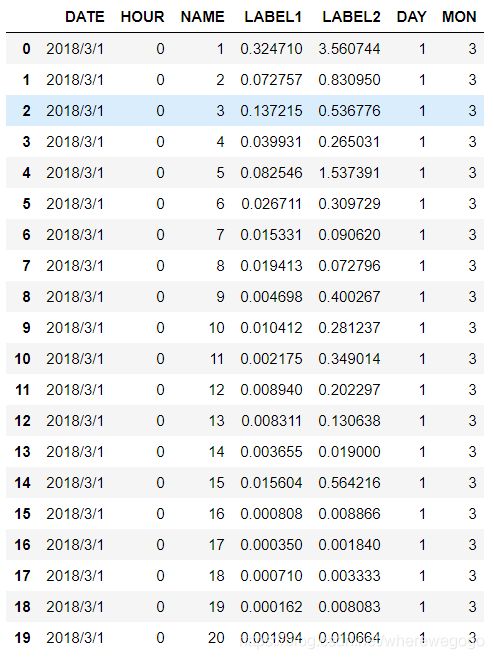MathorCup高校数学建模挑战赛——大数据竞赛 赛道A 移动通信基站流量预测baseline
文章目录
- 前言
- 一、简单分析
- 二、具体程序
-
- 1.引入库
- 2.读入数据
- 3.数据处理
- 4.模型训练和预测
- 5.结果文件输出
- 总结
前言
本文给出2020年MathorCup高校数学建模挑战赛——大数据竞赛中的赛道A移动通信基站流量预测的baseline,这个题目的具体描述和数据集请见链接。
整个程序是用python写的,步骤包括文件读取、数据处理、特征构造、模型训练和预测、输出文件保存。读者可以在本文的基础上进行模型的提升。
一、简单分析
本文的训练数据有9G左右的大小,且特征字段是中文的,panda读取的时候需要注意。另外,训练数据中含有重复项,程序中直接删除了重复项只保留一个。关于日期字段,训练数据中的格式有两种例如“2018/3/26”和“018-4-09”因此需要分别处理,baseline中的程序使用的是通用的处理方式。需要注意的是,baseline的程序是将两个流量当作关于时间的函数,没有考虑时间序列特性,这里有很大的改进空间。但是如果考虑时序特性的话,不能直接使用程序中的交叉验证方法,这样会存在数据泄露,并且需要考虑对缺失值进行填充。
二、具体程序
1.引入库
import pandas as pd
import numpy as np
from tqdm import tqdm
import os
import lightgbm as lgb
import warnings
from sklearn.metrics import mean_squared_error
from sklearn.model_selection import StratifiedKFold, KFold
import gc
import time
2.读入数据
博主将训练数据和测试数据全都重命名了,其实可以不用,这里读取必须要用gbk编码,这样才能读取中文。另外移植代码的时候注意路径匹配。
train = pd.read_csv('D:/mathorup/traindata.csv',encoding="gbk")
test1 = pd.read_csv('D:/mathorup/test1.csv',encoding="gbk")#短期测试集
test2 = pd.read_csv('D:/mathorup/test2.csv',encoding="gbk")#长期测试集
train.info()
为了方便后续处理,我用英文字段重命名了列名:
new_col = ['DATE', 'HOUR','NAME' , 'LABEL1','LABEL2']
train.columns = new_col
test1.columns = new_col
new_col2 = ['DATE','NAME' , 'LABEL1','LABEL2']
test2.columns = new_col2
输出进行观察:
train.head()
test1.head()
test2.head()
3.数据处理
删除训练数据中的重复列,保留一个:
train = train.drop_duplicates(keep='first')
删除含有缺失值的数据
train = train.dropna()
处理小时、日、月:
train['HOUR'] = train['HOUR'].apply(lambda x: int(x.split(':')[0]))
train['DAY'] = train['DATE'].apply(lambda x: int(x.split('/')[-1][-2:]))
train['MON'] = train['DATE'].apply(lambda x: int(x[5]))
测试集1做相同处理:
test1['HOUR'] = test1['HOUR'].apply(lambda x: int(x.split(':')[0]))
test1['DAY'] = test1['DATE'].apply(lambda x: int(x.split('/')[-1]))
test1['MON'] = test1['DATE'].apply(lambda x: int(x[5]))
输出观察:
train.head(20)
4.模型训练和预测
模型我使用的是LGB模型,参数没有进行过优化,大家可以稍微做一下参数优化。训练和预测我使用了两个随机种子和五折交叉验证:
上行流量预测:
used_feat = ['HOUR','DAY','NAME','MON']
train_x = train[used_feat]
train_y = train['LABEL1']
test_x = test1[used_feat]
print(train_x.shape, test_x.shape)
# -----------------------------------------------
scores = []
params = {
'learning_rate': 0.1,
'boosting_type': 'gbdt',
'objective': 'regression',
'metric': 'rmse',
'min_child_samples': 46,
'min_child_weight': 0.01,
'feature_fraction': 0.8,
'bagging_fraction': 0.8,
'bagging_freq': 2,
'num_leaves': 16,
'max_depth': 5,
'n_jobs': -1,
'seed': 2019,
'verbosity': -1,
}
oof_train = np.zeros(len(train_x))
preds = np.zeros(len(test_x))
folds = 5
seeds = [2048, 1997]
for seed in seeds:
kfold = KFold(n_splits=folds, shuffle=True, random_state=seed)
for fold, (trn_idx, val_idx) in enumerate(kfold.split(train_x, train_y)):
print('fold ', fold + 1)
x_trn, y_trn, x_val, y_val = train_x.iloc[trn_idx], train_y.iloc[trn_idx], train_x.iloc[val_idx], train_y.iloc[val_idx]
train_set = lgb.Dataset(x_trn, y_trn)
val_set = lgb.Dataset(x_val, y_val)
model = lgb.train(params, train_set, num_boost_round=5000,
valid_sets=(train_set, val_set), early_stopping_rounds=25,
verbose_eval=50)
oof_train[val_idx] += model.predict(x_val) / len(seeds)
preds += model.predict(test_x) / folds / len(seeds)
del x_trn, y_trn, x_val, y_val, model, train_set, val_set
gc.collect()
mse = (mean_squared_error(oof_train, train['LABEL1']))
print('-'*120)
print('rmse ', round(mse, 5))
test1['LABEL1'] = preds
下行流量预测:
train_x = train[used_feat]
train_y = train['LABEL2']
test_x = test1[used_feat]
print(train_x.shape, test_x.shape)
# -----------------------------------------------
scores = []
params = {
'learning_rate': 0.1,
'boosting_type': 'gbdt',
'objective': 'regression',
'metric': 'rmse',
'min_child_samples': 46,
'min_child_weight': 0.01,
'feature_fraction': 0.8,
'bagging_fraction': 0.8,
'bagging_freq': 2,
'num_leaves': 16,
'max_depth': 5,
'n_jobs': -1,
'seed': 2019,
'verbosity': -1,
}
oof_train = np.zeros(len(train_x))
preds = np.zeros(len(test_x))
folds = 5
seeds = [2048, 1997]
for seed in seeds:
kfold = KFold(n_splits=folds, shuffle=True, random_state=seed)
for fold, (trn_idx, val_idx) in enumerate(kfold.split(train_x, train_y)):
print('fold ', fold + 1)
x_trn, y_trn, x_val, y_val = train_x.iloc[trn_idx], train_y.iloc[trn_idx], train_x.iloc[val_idx], train_y.iloc[val_idx]
train_set = lgb.Dataset(x_trn, y_trn)
val_set = lgb.Dataset(x_val, y_val)
model = lgb.train(params, train_set, num_boost_round=5000,
valid_sets=(train_set, val_set), early_stopping_rounds=25,
verbose_eval=50)
oof_train[val_idx] += model.predict(x_val) / len(seeds)
preds += model.predict(test_x) / folds / len(seeds)
del x_trn, y_trn, x_val, y_val, model, train_set, val_set
gc.collect()
mse = (mean_squared_error(oof_train, train['LABEL2']))
print('-'*120)
print('rmse ', round(mse, 5))
test1['LABEL2'] = preds
5.结果文件输出
由于我们对原文件做了较大的改动,上交的文件要处理成原文件的格式:
test11 = pd.read_csv('D:/mathorup/test1.csv',encoding="gbk")#短期测试集
test11['上行业务量GB'] = test1['LABEL1']
test11['下行业务量GB'] = test1['LABEL2']
test11.to_csv('短期验证选择的小区数据集.csv', index = False)
test11.head()
总结
本文仅仅给出了一种简单的方法,打通了整个流程,还有很大的提升空间,比如考虑时序特性、数据相关性分析、改用LSTM等神经网络模型等等。
